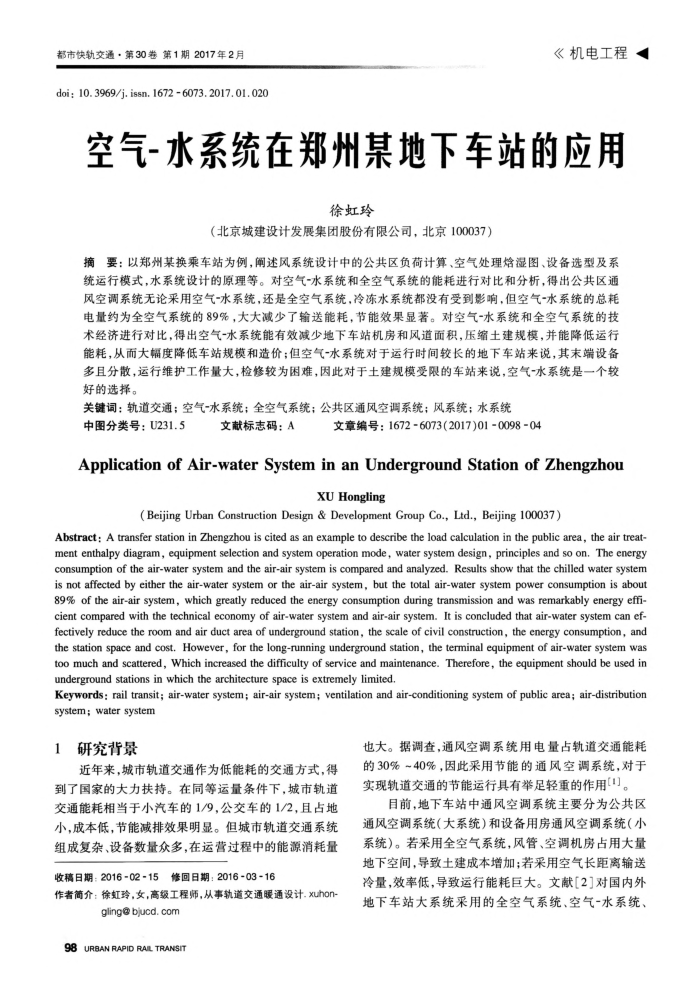您当前的位置:首页>论文资料>空气-水系统在郑州某地下车站的应用
内容简介
 都市快轨交通·第30卷第1期2017年2月
都市快轨交通·第30卷第1期2017年2月doi; 10.3969/j. issn.1672-6073.2017.01.020
《机电工程
空气-水系统在郑州某地下车站的应用
徐虹玲
(北京城建设计发展集团股份有限公司,北京100037)
摘要:以郑州某换乘车站为例,阐述风系统设计中的公共区负荷计算、空气处理湿图、设备选型及系统运行模式,水系统设计的原理等。对空气-水系统和全空气系统的能耗进行对比和分析,得出公共区通风空调系统无论采用空气-水系统,还是全空气系统,冷冻水系统都没有受到影响,但空气-水系统的总耗电量约为全空气系统的89%,大大减少了输送能耗,节能效果显著。对空气-水系统和全空气系统的技术经济进行对比,得出空气-水系统能有效减少地下车站机房和风道面积,压缩土建规模,并能降低运行能耗,从而大幅度降低车站规模和造价;但空气-水系统对于运行时间较长的地下车站来说,其末端设备多且分散,运行维护工作量大,检修较为围难,因此对于土建规模受限的车站来说,空气-水系统是一个较好的选择。
关键词:轨道交通;空气-水系统;全空气系统;公共区通风空调系统;风系统;水系统
中图分类号:U231.5
文献标志码:A
文章编号:1672-6073(2017)01-0098-04
ApplicationofAir-waterSysteminanUndergroundStationofZhengzhou
XU Hongling
(Beijing Urban Construction Design & Development Group Co., Ltd., Beijing 100037)
Abstract: A transfer station in Zhengzhou is cited as an example to describe the load calculation in the public area, the air treat neaaassaeaaseoaaaeea consumption of the air-water system and the air-air system is compared and analyzed. Results show that the chilled water system oasaaeaaeeaaes 89% of the air-air system, which greatly reduced the energy consumption during transmission and was remarkably energy effi-cient compared with the technical economy of air-water system and air-air system. It is concluded that air-water system can ef-fectively reduce the room and air duct area of underground station, the scale of civil construction, the energy consumption, and the station space and cost. However, for the long-running underground station, the terminal equipment of air-water system was too much and scattered, Which increased the difficulty of service and maintenance. Therefore, the equipment should be used in underground stations in which the architecture space is extremely limited.
Keywords: rail transit; air-water system; air-air system; ventilation and air-conditioning system of public area; air-distribution system;water system
1
研究背景
近年来,城市轨道交通作为低能耗的交通方式,得
到了国家的大力扶持。在同等运量条件下,城市轨道交通能耗相当于小汽车的1/9,公交车的1/2,且占地小,成本低,节能减排效果明显。但城市轨道交通系统组成复杂、设备数量众多,在运营过程中的能源消耗量
收稿日期:2016-02-15修回日期:2016-03-16
作者简介:徐虹玲,女,高级工程师,从事轨道交通暖通设计.xuhon
gling@ bjucd. com
98 URBAN RAPID RAILTRANSIT
也大。据调查,通风空调系统用电量占轨道交通能耗的30%~40%,因此采用节能的通风空调系统,对于实现轨道交通的节能运行具有举足轻重的作用1]。
目前,地下车站中通风空调系统主要分为公共区通风空调系统(大系统)和设备用房通风空调系统(小系统)。若采用全空气系统,风管、空调机房占用大量地下空间,导致土建成本增加;若采用空气长距离输送冷量,效率低,导致运行能耗巨大。文献[2]对国内外地下车站大系统采用的全空气系统、空气-水系统